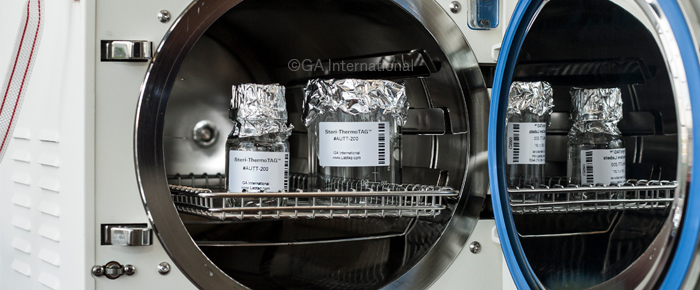
Sterilization is at the backbone of a variety of laboratories and healthcare facilities, including hospitals, dental offices, and wet labs that work with living specimens. Autoclaving is likely the most popular form of sterilization, utilizing high heat and pressure to kill microorganisms found on metal, plastic, and glass surfaces. Here are several helpful tips to maximize your steam autoclave cycles, ensuring items are properly sterilized while remaining accurately identified from cycle to cycle.
Don’t lock lids
This is a mistake most people only make once in their lifetime: fully closing bottles then autoclaving them. This is because the pressure generated from the autoclave cycle is enough to force the bottle to explode if fully closed, resulting in glass and potentially hazardous liquids spewing all over the machine. Instead, leave the bottle open enough to ensure the pressure does not build up. If concerns arise that the bottles can become quickly contaminated when taken out of the autoclave, wrapping a piece of aluminum over the top of the half-open bottle prior to autoclaving will prevent bacteria from creeping in until you can fully close the bottle after the cycle is complete.
Use proper autoclave bins or trays
Not all sterilization bins are created equal, especially when it comes to autoclaving. If using plastic bins, always ensure they are made of either polycarbonate or polypropylene. Metal bins can also resist autoclaving but typically absorb more heat than plastic bins and cool down slower, making them more of a potential burn hazard once they are taken out of the autoclave. Bins made of polyethylene bins are incompatible with autoclaves and can easily melt, resulting in a situation that costs time and money to clean up.
Use proper labels
When using any sterilization technique, it’s essential to apply the correct label. Autoclave labels, such as Steri-ThermoTAG™ and Steri-LazrTAG™, are designed to resist high heat and pressure (temperatures as high as 150°C and pressures as high as 17 psi), ensuring they maintain adherence during and after autoclave sterilization cycles. These labels can be permanent or removable; removable labels are especially useful as they will not leave a thick residue on glass, metal, or plastic surfaces when autoclaved. Thermal-transfer printable labels are also recommended, as this printing method provides optimal resistance against high temperatures and pressure. In contrast, direct thermal labels should only be used if you intend to conceal previous information found on the container. This is because direct thermal labels are coated with a leuco dye that changes color in response to the heated printhead. Thus, placing these labels in an environment of high heat will cause the entire label to blacken.
Use indicators
At least one of two types of indicators available for autoclaving should be used to ensure that materials are properly sterilized after the cycle. The most common type of indicator is autoclave tape, which is widely used throughout almost every lab. Certain tapes, like removable SteriTAPE™, are glove-friendly and easily removable without leaving residue and can be made with patented GatorCUT™ technology. The liner-free design of GatorCUT allows the tape to easily hand-tear to the desired length without the need for scissors, dispensers, or other cutting instruments. If autoclave tape is not used, a chemical indicator can be placed in the tray, which will change color in response to high heat and pressure, either through a phase change in the chemical indicator (from solid to liquid) or via a chemical reaction that produces the color change.
Don’t overload steam autoclaves
Items placed in the autoclave require adequate spacing to ensure the steam penetrates and circulates throughout. This is especially problematic when porous items, such as cloth or paper, are loaded close together, which results in water retention and makes the items challenging to dry. This may also prevent full sterilization of the items.
LabTAG by GA International is a leading manufacturer of high-performance specialty labels and a supplier of identification solutions used in research and medical labs as well as healthcare institutions.